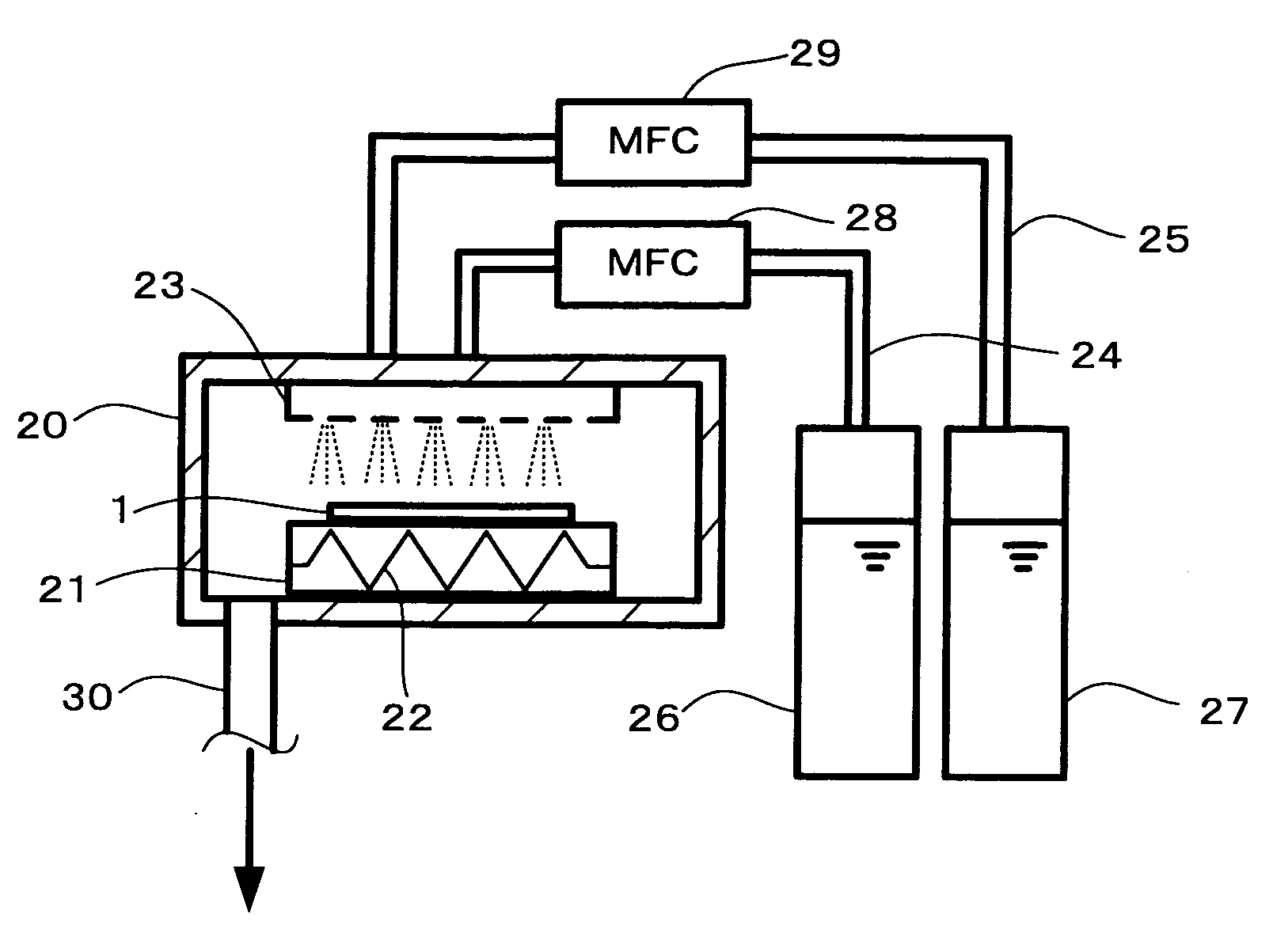Method for reducing metal, multilayer interconnection structure and manufacturing method for the same, and semiconductor device and manufacturing method for the same
a technology of multilayer interconnection structure and manufacturing method, applied in semiconductor/solid-state device manufacturing, basic electric elements, electric apparatus, etc., can solve the problems of reducing signal propagation speed, and less effect of interconnection delay on the whole of the semiconductor device, so as to reduce parasitic capacity, reduce interconnection resistance, and increase the permittivity of the insulating film
- Summary
- Abstract
- Description
- Claims
- Application Information
AI Technical Summary
Benefits of technology
Problems solved by technology
Method used
Image
Examples
example 1
[0148]A silicon wafer 1 provided with the foregoing porous silica film was placed on a support board 21 in a chamber 20 of a metal reduction apparatus as shown in FIG. 1. Subsequently, a reduction source (ethyl formate) and a hydrolysis source (water) were heated to temperatures described below, vaporized, and introduced in the chamber 20 at flow rates described below. In this way the porous silica film on the silicon wafer 1 was exposed to the reduction treatment environment described below. Note that the substrate temperature described below indicates the temperature of the silicon wafer 1 heated by a heater 22 provided in the chamber 20.
-Reduction Source-
[0149]Source: Ethyl formate
[0150]Source heating temperature: 80° C.
[0151]Flow rate: 400 sccm
Hydrolysis Source
[0152]Source: Water
[0153]Source heating temperature: 80° C.
[0154]Flow rate: 100 sccm
[0155]Substrate temperature: 250° C.
[0156]Pressure in chamber: 100 Pa
[0157]Treatment time: 180 seco...
example 2
[0159]A porous silica film on a silicon wafer, obtained in a manner similar to that described above, was exposed to the reduction treatment atmosphere of Example 2 using a metal reduction apparatus similar to that of Example 1, shown in FIG. 1, in a manner similar to that described in Example 1 except that the reduction source was changed to the species described below.
-Reduction Source-
[0160]Source: Ethyl acetate
[0161]Source heating temperature: 80° C.
[0162]Flow rate: 400 sccm
-Hydrolysis Source-
[0163]Source: Water
[0164]Source heating temperature: 80° C.
[0165]Flow rate: 100 sccm
[0166]Substrate temperature: 250° C.
[0167]Pressure in chamber: 100 Pa
[0168]Treatment time: 180 seconds
[0169]After exposing the porous silica film to such an environment, permittivity was measured in a manner similar to that used for the measurement before the exposure treatment; permittivity was not changed from 2.3.
example 3
[0170]A porous silica film on a silicon wafer, obtained in a manner similar to that described above, was exposed to the reduction treatment atmosphere of Example 3 using a metal reduction apparatus similar to that of Example 1, shown in FIG. 1, in a manner similar to that described in Example 1 except that the reduction source was changed to the species described below.
-Reduction Source-
[0171]Source: Methyl propionate
[0172]Source heating temperature: 80° C.
[0173]Flow rate: 400 sccm
-Hydrolysis Source-
[0174]Source: Water
[0175]Source heating temperature: 80° C.
[0176]Flow rate: 100 sccm
[0177]Substrate temperature: 250° C.
[0178]Pressure in chamber: 100 Pa
[0179]Treatment time: 180 seconds
[0180]After exposing the porous silica film to such an environment, permittivity was measured in a manner similar to that used for the measurement before the exposure treatment; permittivity was not changed from 2.3.
PUM
| Property | Measurement | Unit |
|---|---|---|
| Temperature | aaaaa | aaaaa |
| Temperature | aaaaa | aaaaa |
| Temperature | aaaaa | aaaaa |
Abstract
Description
Claims
Application Information
 Login to View More
Login to View More - R&D
- Intellectual Property
- Life Sciences
- Materials
- Tech Scout
- Unparalleled Data Quality
- Higher Quality Content
- 60% Fewer Hallucinations
Browse by: Latest US Patents, China's latest patents, Technical Efficacy Thesaurus, Application Domain, Technology Topic, Popular Technical Reports.
© 2025 PatSnap. All rights reserved.Legal|Privacy policy|Modern Slavery Act Transparency Statement|Sitemap|About US| Contact US: help@patsnap.com



